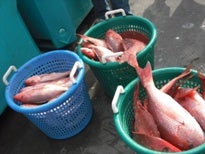 For over 20 years I’ve worked in the field of fisheries and ocean conservation, mostly in the Gulf of Mexico. During that time I’ve been privileged to catch and enjoy the region’s red snapper, kingfish and flounder. In my view, we can and should balance conservation of the region’s resources with people’s need for jobs, food, and enjoyment. In fact, finding the balance is at the heart of the Gulf’s future.
For over 20 years I’ve worked in the field of fisheries and ocean conservation, mostly in the Gulf of Mexico. During that time I’ve been privileged to catch and enjoy the region’s red snapper, kingfish and flounder. In my view, we can and should balance conservation of the region’s resources with people’s need for jobs, food, and enjoyment. In fact, finding the balance is at the heart of the Gulf’s future.
Fisheries management – especially when commercial and recreational goals seem at odds – has been controversial since federal regulations came into play in the 1980s. A newly used tool in the Gulf called “catch shares” is currently getting a lot of attention, some of it from anglers concerned that it is responsible for increasing recreational regulations and shrinking access. This is a misconception.
Recently, an author on the Florida Sportsman’s Conservation Blog questioned whether Environmental Defense Fund is contradicting itself in supporting catch shares to solve overfishing problems in federal commercial fisheries. The answer is: “not at all.” As an organization, EDF works in partnership with industry and communities to find solutions to environmental problems that are also good for the economy. This is exactly what the Gulf’s catch share programs achieve. They were implemented with industry leadership and support and are achieving the fishery’s conservation and economic goals.
“Catch share” management divides a scientifically-set catch limit among fishermen and holds each individually responsible. A fisherman can fish year-round as long as he stays within his limit. If he wants to catch more, he can obtain shares from another fisherman. In contrast, in “derby” management the catch limit is allocated to the fleet as a whole and fishermen race to catch as much as possible before the limit is reached and the season closed.
In 2007, the commercial red snapper fishery became the region’s first to switch from a derby to catch shares. The resurgence of the population since then is dramatic, and is good for the Gulf and the country. Fresh fish are available year-round to consumers from Tampa to Denver, rather than a few short months, and there are share caps to safeguard against heavy consolidation (concerns raised in the blog). Long-standing overfishing has finally ended with commercial fishermen staying within the catch limit and discarding far fewer fish compared to derby days. Coastal businesses linked to fishing are busier and fishing-related jobs are becoming more stable. Free from costly and ineffective trip limits, fishermen report spending less to catch the fish.
As important as red snapper are to commercial fisheries, we know that recreational fishermen value them just as much. In a critical way the switch to commercial catch share management is good for the recreational fishery – year after year commercial fishermen have stayed within the scientific limit, helping to rebuild the fish population. Now the catch limit, for both commercial and recreational fishermen, is steadily rising and is 60 percent higher than in 2008. That means the stock is healthy and recreational fishermen have more fish to catch in large part due to the successful commercial catch share fishery.
Unfortunately, sportsmen have a hard time seeing all the benefits of the recovering red snapper fishery. While Florida anglers may see first-hand the re-expansion of the fish across Florida, they still face short seasons, high size limits, and low bag limits. The management choices on the table – give up a few days for a two-fish limit, or gain a few with a one-fish limit – are bad for anglers, for-hire captains and sport businesses, and the red snapper population – just as they were for commercial fishermen under derbies.
We believe there’s light at the end of the tunnel. We’re beginning to see proposals that offer hope for new choices. Gulf charter and headboat captains have proposed new ideas, ranging from a headboat cooperative, to “days at sea”, to better and faster data using new technologies. Some will prove better than others, but they’re on target looking for regulatory flexibility and access, accurate fish counting, and industry incentives for conservation. It is evident that tweaking seasons and bag limits won’t ever work, but innovation and collaboration are proving they can sustain the Gulf’s bounty.
We value our partnerships with fishermen in Florida and across the country, and look forward to working with anglers and others interested in sustaining fish and the Gulf’s heritage of fishing.









